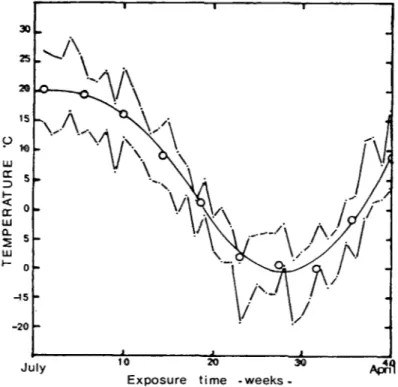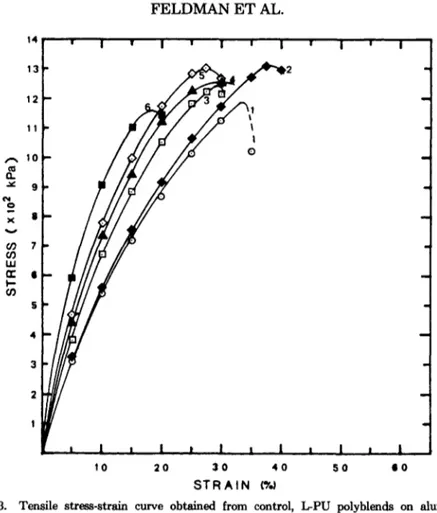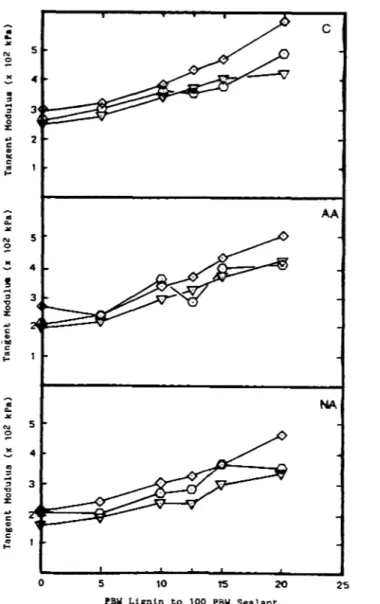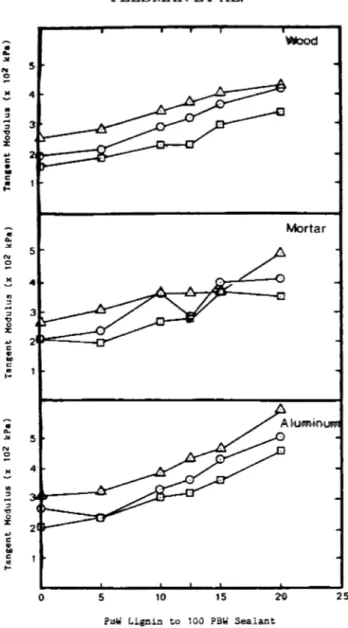Publisher’s version / Version de l'éditeur:
Journal of Applied Polymer Science, 35, 1, pp. 247-257, 1988-01-01
READ THESE TERMS AND CONDITIONS CAREFULLY BEFORE USING THIS WEBSITE. https://nrc-publications.canada.ca/eng/copyright
Vous avez des questions? Nous pouvons vous aider. Pour communiquer directement avec un auteur, consultez la
première page de la revue dans laquelle son article a été publié afin de trouver ses coordonnées. Si vous n’arrivez pas à les repérer, communiquez avec nous à PublicationsArchive-ArchivesPublications@nrc-cnrc.gc.ca.
Questions? Contact the NRC Publications Archive team at
PublicationsArchive-ArchivesPublications@nrc-cnrc.gc.ca. If you wish to email the authors directly, please see the first page of the publication for their contact information.
NRC Publications Archive
Archives des publications du CNRC
This publication could be one of several versions: author’s original, accepted manuscript or the publisher’s version. / La version de cette publication peut être l’une des suivantes : la version prépublication de l’auteur, la version acceptée du manuscrit ou la version de l’éditeur.
For the publisher’s version, please access the DOI link below./ Pour consulter la version de l’éditeur, utilisez le lien DOI ci-dessous.
https://doi.org/10.1002/app.1988.070350118
Access and use of this website and the material on it are subject to the Terms and Conditions set forth at
Polyurethane-based sealants modified by blending with Kraft lignin
Feldman, D.; Lacasse, M.; St. J. Manley, R.
https://publications-cnrc.canada.ca/fra/droits
L’accès à ce site Web et l’utilisation de son contenu sont assujettis aux conditions présentées dans le site
LISEZ CES CONDITIONS ATTENTIVEMENT AVANT D’UTILISER CE SITE WEB.
NRC Publications Record / Notice d'Archives des publications de CNRC:
https://nrc-publications.canada.ca/eng/view/object/?id=c9b4fe05-3368-4351-9b80-70406ba86f94 https://publications-cnrc.canada.ca/fra/voir/objet/?id=c9b4fe05-3368-4351-9b80-70406ba86f94Polyurethane-Based Sealants Modified by
Blending with Kraft
Lignin
zyxwvutsrqponmlkjihgfedcbaZYXWVUTSRQPONMLKJIHGFEDCBA
D. FELDMAN, and M. LACASSE, Centre for Building
zyxwvutsrqponmlkjihgfedcbaZYXWVUTSRQPONMLKJIHGFEDCBA
zyxwvutsrqponmlkjihgfedcbaZYXWVUTSRQPONMLKJIHGFEDCBA
Studies, Concordia University, Montreal Canada, andR.
St. J. MANLEY,Department
zyxwvutsrqponmlkjihgfedcbaZYXWVUTSRQPONMLKJIHGFEDCBA
of Chenistry, McGill Uniuersity, Montreal, Canada.Synopsis
zyxwvutsrqponmlkjihgfedcbaZYXWVUTSRQPONMLKJIHGFEDCBA
An investigation was conducted to establish the viability of blending Kraft lignin (L), a naturally occurring, readily available polymer resource, with polyurethane- (PU) based sealants. The sealants were tested in a detailed program where lignin-sealant blends, having blend ratios varying between 0 and 20 pbw L, were prepared on substrates of aluminum, mortar, and wood, and subjected to laboratory control (C), artificial weathering (AW), and natural weathering (NW)
conditions. Results of tension testing showed that generally, lignin acts
zyxwvutsrqponmlkjihgfedcbaZYXWVUTSRQPONMLKJIHGFEDCBA
as a reinforcing agent which adds rigidity to the polymeric matrix, as indicated by the increase in toughness andmodulus of blended sealants with the addition of lignin. In addition, the curing mode of PU, as
determined by sequence hardness testing, was modified
zyxwvutsrqponmlkjihgfedcbaZYXWVUTSRQPONMLKJIHGFEDCBA
with the addition of lignin. INTRODUCTIONThe properties of polymer blends has become an area of major scientific research in the last 15 years due in large part to the intensified technological and economic interest in multicomponent macromolecular systems. The blend- ing of two or more different polymers is carried out in order to enhance certain characteristics of the final product when compared with the initial polymers.
Most of the literature on polymer mixtures deals with mixing binary blends of synthetic polymers such as thermoplastics or elastomers with thermoplas- tics. Much less material
has
been published on the blending of synthetic and natural polymers and this is particularly true in the case of polyblends formulated with different types of lignin.In this laboratory, previous research on polymer mixtures involved the study of properties of blends of polyurethane, epoxy, and silicone, respec- tively, with vinyl type polymers, polyorganosiloxane, or glass fiber rein- forcement.'-' Subsequent papers reported results on acrylic terpolymer-based blends with improved mechanical properties!-'O
This
paper reports results on the curing mode and mechanical performance of polyurethane-based sealants blended with Kraft lignin (L)to
enhance the mechanical and curing behavior of these blends.EXPERIMENTAI,
Materials
The base polymer used was a one part self-curing, non-sag polyurethane-
(PU) based sealant (MULCO-Maxiflex).
Journal of Applied Polymer Science, Vol.
zyxwvutsrqponmlkjihgfedcbaZYXWVUTSRQPONMLKJIHGFEDCBA
35, 247-257 (1988)248 FELDMAN E T
AL.
zyxwvutsrqponmlkjihgfedcbaZYXWVUTSRQPONMLKJIHGFEDCBA
Kraft lignin (L), obtained from Domtar of Cornwall (Ontario), was the base
polymer with which
PU
zyxwvutsrqponmlkjihgfedcbaZYXWVUTSRQPONMLKJIHGFEDCBA
was blended, The lignin was extracted from blackliquor (pulping residue from maple, beech, and elm hardwoods) by sulfuric acid precipitation. The pH of the precipitate was adjusted with carbon dioxide to a level between 6 and 7.11 PU-based blends with 5,10, 12.5, 15, and
20 parts by weight (pbw) L were prepared.
zyxwvutsrqponmlkjihgfedcbaZYXWVUTSRQPONMLKJIHGFEDCBA
Procedure
The testing program consisted of establishing the curing mode of lignin- polyurethane (L-PU) blends as well as the mechanical properties in tension.
The curing of elastomeric sealants normally involves the formation of
crosslinkages between the macromolecular chains; the cure process proceeds through the sealant, and may be detected by sequence hardness testing. The hardness of the various blends was determined according to ASTM C 661-70, using a Shore type A-2 durometer.
For the tension testing of lignin-polymeric blends, three series of six speci- mens were cast between aluminum, mortar (ASTM method C 719-79), and California redwood substrates in accordance with CAN2-19.6-M77, method 12.1 1978. After curing, each of the series was subjected to one of the following conditions:
1. Control (C); kept in the laboratory a t 23°C and 35% relative humidity
(RH). I I I
zyxwvutsrqponmlkjihgfedcbaZYXWVUTSRQPONMLKJIHGFEDCBA
-
-
-
W a I 5 -zyxwvutsrqponmlkjihgfedcbaZYXWVUTSRQPONMLKJIHGFEDCBA
zyxwvutsrqponmlkjihgfedcbaZYXWVUTSRQPONMLKJIHGFEDCBA
0 - W t- 4 5-
-20-
b I 1 14
q
10 20 33Exposure time -weeks
-
JulyFig. 1. NW exposure conditions: average weekly maximum and minimum temperatures, and
MODIFIED POLYURETHANE-BASED SEALANTS
zyxwvutsrqponmlkjihgfedcbaZYXWVUTSRQPONMLKJIHGFEDCBA
249 2. Artificial weathering (AW); specimens were placed in an environmentalchamber whose temperature was set to cycle between
zyxwvutsrqponmlkjihgfedcbaZYXWVUTSRQPONMLKJIHGFEDCBA
- 30 and+
40°C a t 50%RH (4
times daily) for 180 days (i.e., 720 cycles); the specimens were concur- rently subjected to ultraviolet radiation (wavelength 254 nm) for 12 of 24 hours.3. Natural weathering (NW); specimens were placed outdoors in a relatively polluted area of central Montreal for 37 weeks, between July 1985 and April
1986. The temperature variation during the exposure period is shown in Figure 1.
Maximum and
zyxwvutsrqponmlkjihgfedcbaZYXWVUTSRQPONMLKJIHGFEDCBA
minimum temperatures recorded during this period were32.6"C and
-
26.7"C, respectively.Tensile stress-strain measurements were performed at 23°C with an In- stron Model 1125 Universal Testing Machine, using a 500 kg load cell set at a
full scale of 100 kg. A cross-head speed of 2 mm/min was
used
zyxwvutsrqponmlkjihgfedcbaZYXWVUTSRQPONMLKJIHGFEDCBA
in conjunctionwith a 20 mm/min chart speed
to
produce a reasonably comprehensive plot of the stress-strain data.Testing was conducted until there was a visible adhesive or cohesive failure
or until the results recorded on the chart indicated a
zyxwvutsrqponmlkjihgfedcbaZYXWVUTSRQPONMLKJIHGFEDCBA
sharp
decrease in load.RESULTS AND DISCUSSION Curing Characteristics
For the neat PU blends, the initial hardening
test
may be recorded after approximately 25 h have elapsed since the initial casting time. In the next 23 h, the sealant reaches 40% of the hardness obtained in one week and in the following 24 h, 70% of the one week hardness. The hardness after one week is 95% of the average hardness over 1519 h, indicating that most of the cure occurs in the first week after initial set. It should also be observed that a second hardening stage may occur after several months.It
is not yet apparent what causes the subsequent hardening of the sealant after two months of curing.For L-PU blends of 20 pbw of lignin, the initial hardness reading may be taken at 20 h, representing a 20% decrease in initial set time for this blended sealant in comparison to the neat sealant. The polyblend reaches 35% of its one week hardness after 24 h, 72% of its hardness in 48 h, and 85% of its hardness after 72 h from initial set. Generally, this is indicative of a more rapid cure for blended sealants in comparison to neat PU. This is all the more evident when considering the results shown in Figure 2 which shows curing
tests for L-PU blend ratios of 0, 10, and 20 pbw L.
The curing time,
zyxwvutsrqponmlkjihgfedcbaZYXWVUTSRQPONMLKJIHGFEDCBA
as measured by sequence hardness testing, is affected bythe amount of lignin blended with the base sealant. Furthermore, it can be shown that at any given time, the ratio of 10 sec (i.e., reading obtained 10
seconds after initial indentation) to
zyxwvutsrqponmlkjihgfedcbaZYXWVUTSRQPONMLKJIHGFEDCBA
60 sec hardness decreases with increasingamounts of lignin, indicating a more rapid hardening process for blended vs. unblended sealants. Although the rate of curing appears to be similar for blended and unblended sealants, as indicated by the initial linear portion of the curves, overall, blended sealants harden more quickly than unblended
250
Indentation
zyxwvutsrqponmlkjihgfedcbaZYXWVUTSRQPONMLKJIHGFEDCBA
hardness ofzyxwvutsrqponmlkjihgfedcbaZYXWVUTSRQPONMLKJIHGFEDCBA
L-PU oolvblends in relation to curing time. Curve - "zyxwvutsrqponmlkjihgfedcbaZYXWVUTSRQPONMLKJIHGFEDCBA
1: L-PU,zyxwvutsrqponmlkjihgfedcbaZYXWVUTSRQPONMLKJIHGFEDCBA
0 : loo; 2:
zyxwvutsrqponmlkjihgfedcbaZYXWVUTSRQPONMLKJIHGFEDCBA
L-Pu; 10 : loo, 3: L-PU; 20 : loo.sealants in direct proportion to the amount of lignin present in the blend. A
discussion of the basic chemistry involved in the formation of
PU,
more specifically one component polyurethane sealants, is required to explain thisphenomena. One component polyurethane sealants are produced by the reac- tion of moisture and an isocyanate-terminated prepolymer such as alkyl trimethyl triisocyanate, which here is referred to as:
R- (NCO)
Combining 3 mol of water with the isocyanate yields an amirie, which further reacts with the isocyanate to form urethane linkages, i.e.:
3H20
+
R-(NCO), -+ R--(NH,),+
3C0, amine R-(NH2)3+
R--(NCO), -+ H O H H O H H O HI
II
I
I
II
I
I
II
I
...-
N-C- N-R- N-C- N-R- N-C- N-...
UrethaneMODIFIED POLYURETHANE-BASED SEALANTS
zyxwvutsrqponmlkjihgfedcbaZYXWVUTSRQPONMLKJIHGFEDCBA
251The rate of cure is affected by the activity of the functional end groups, and
the presence of catalysts. The
zyxwvutsrqponmlkjihgfedcbaZYXWVUTSRQPONMLKJIHGFEDCBA
hardness
of the cured products depends on thecrosslinking density between molecular chains and the rigidity of the chains, which increases with a corresponding increase in the number of aromatic groups along the chain. Furthermore, the crosslink density is a function of the type of prepolymer
used
in the sealant formulation. It is thought that theincorporation of lignin into the PU matrix may be seen
zyxwvutsrqponmlkjihgfedcbaZYXWVUTSRQPONMLKJIHGFEDCBA
as addingto
thecrosslink density by increasing the concentration of aromatic groups within the polymeric network.
A possible mechanism might be based on the interaction of lignin hydroxyl
groups with free isocyanate groups. That is,
zyxwvutsrqponmlkjihgfedcbaZYXWVUTSRQPONMLKJIHGFEDCBA
-
Lignin-OH
+
ONC-PU- >Lignin-0- C -NH-PU
II
0
zyxwvutsrqponmlkjihgfedcbaZYXWVUTSRQPONMLKJIHGFEDCBA
An infrared (IR) spectroscopic study was carried out to determine the existence of chemical interaction between L and PU. Unfortunately, experi-
mental difficulties encountered while establishing the spectra have
zyxwvutsrqponmlkjihgfedcbaZYXWVUTSRQPONMLKJIHGFEDCBA
so far madeaccurate conclusions impossible.
Tension Testing of (LPU) Polyblends
zyxwvutsrqponmlkjihgfedcbaZYXWVUTSRQPONMLKJIHGFEDCBA
L-PU blends on Aluminum Substrates
Figure 3 shows a series of typical stress-strain curves obtained from tension
tests which, in this particular
zyxwvutsrqponmlkjihgfedcbaZYXWVUTSRQPONMLKJIHGFEDCBA
case, describe the behavior of specimens sub-jected to control conditions. Those specimens with 5 pbw lignin show the
highest values (curve 2) for yield stress. All other blends tested (curves 3-5),
with the exception of the 20 pbw L blend (curve
zyxwvutsrqponmlkjihgfedcbaZYXWVUTSRQPONMLKJIHGFEDCBA
6), have higher yield stressthan the neat PU sealant (curve 1).
The greatest percentage increase in toughness, tangent modulus (5% offset), and stress and strain a t yield is observed for blends having 5 pbw of lignin in the matrix (Tables I and 11). In other blends in this series, additional lignin decreases both the toughness and the strain at yield. However up to a limiting value of 15 pbw L, there are increases in stress at yield, in comparison to the values obtained for the neat sealant, but not as significant as those for specimens blended with 5 pbw of lignin. It is also observed that the modulus of control specimens increases progressively with the addition of lignin.
Similarly for AW specimens, the maximum values for toughness, and stress and strain at yield are obtained in blends with 5 pbw
L;
additional L beyond 5 pbw decreases these values. It mayalso
be shown that, in general terms there is an increase in modulus with the addition of L.For the NW test series, the highest value of yield stress was achieved in blends having 12.5 pbw L (as opposed to 5 pbw L observed in the C & AW
series). Furthermore, the addition of L enhanced the yield stress in all sealants blended with up to 15 pbw of L in comparison to neat PU sealant (Table 11).
252
zyxwvutsrqponmlkjihgfedcbaZYXWVUTSRQPONMLKJIHGFEDCBA
FELDMANET
zyxwvutsrqponmlkjihgfedcbaZYXWVUTSRQPONMLKJIHGFEDCBA
AL.zyxwvutsrqponmlkjihgfedcbaZYXWVUTSRQPONMLKJIHGFEDCBA
14 13 12 1 1 n 108
A 9 x a PIzyxwvutsrqponmlkjihgfedcbaZYXWVUTSRQPONMLKJIHGFEDCBA
0zyxwvutsrqponmlkjihgfedcbaZYXWVUTSRQPONMLKJIHGFEDCBA
c Y # 7 v) W K ( i c v) I 4 3 2 1 10 2 0 3 0 4 0 s o a 0 S T R A I N (YdFig, 3. Tensile stress-strain curve obtained from control, L P U plyblends on
zyxwvutsrqponmlkjihgfedcbaZYXWVUTSRQPONMLKJIHGFEDCBA
aluminumsubstrates. Curve 1: L-PU, 0 : 100, 2: LPU, 5 : 100, 3: L-PU, 10 : 100, 4: L-PU, 12.5 : 100; 5: L-PU,
15 : 100, 6: L-PU, 20 : 100.
TABLE I
Toughness and Tangent Modulus (at 5% strain) of Lignin-Polyurethane Polyblends on Aluminum Substrates
Toughness (KPa) Tangent modulus (KPa) Polyblend Exposure Condition Exposure Condition
L : P U C AW NW C AW NW 0:100 284 297 267 310 269 202 5:100 345 370 315 324 246 239 10 : 100 241 241 263 385 337 309 12.5 : 100 247 182 246 436 365 327 15 : 100 239 177 162 469 433 363 20: 100 149 167 178 595
zyxwvutsrqponmlkjihgfedcbaZYXWVUTSRQPONMLKJIHGFEDCBA
509 465In this test series, as in all other tests on aluminum substrates, the maximum
toughness was observed in blends having 5 pbw L.
Overall, the addition of lignin stiffens the PU matrix such that with 20 pbw of lignin incorporated in the blend, an average increase of 100% in modulus is
MODIFIED POLYURETHANE-BASED SEALANTS 253
zyxwvutsrqponmlkjihgfedcbaZYXWVUTSRQPONMLKJIHGFEDCBA
TABLE I1
Yield Stress and Yield Strain of Lignin-Polyurethane Polyblends on Aluminum Substrates
Yield stress (KPa) Yield strain (%)
zyxwvutsrqponmlkjihgfedcbaZYXWVUTSRQPONMLKJIHGFEDCBA
Polyblend Exposure Condition Exposure Condition L : P U C AW NW C AW NW 0 : 100
zyxwvutsrqponmlkjihgfedcbaZYXWVUTSRQPONMLKJIHGFEDCBA
1191 1191 1038 35.8 37.5 38.5 5:100 1315 1281 1183 39.4 43.0 40.0 10: 100 1225 1174 1186 29.6 30.8 33.3 12.5 : 100 1255 1059 1214 29.6 25.8 30.4 15 : 100 1283 1140 1078 27.9 23.3 22.5 20 : 100 1146 1183 1167 19.6 21.3 22.9zyxwvutsrqponmlkjihgfedcbaZYXWVUTSRQPONMLKJIHGFEDCBA
L-PU Polyblends on Mortar Substrates
For control specimens, the failure mode was dominantly adhesive in nature, placing a limit on the amount of stress induced in the sealant.
For mortar specimens subject to AW conditions, it was observed that a considerable number of substrates had extensive microcracking visible on their surfaces, and the failure mode of these specimens was dominantly initiated in the substrate, being localized a t the interface with the sealant where the highest stress concentrations in the sealant occur. The results obtained were inconsistent and this precludes any valid conclusions being made.
L-PU Blends on Wood Substrates
Lignin-polyurethane blends on wood substrates exhibit lower values for toughness, modulus, and stress and strain at yield (Tables I11 and IV), in comparison to values obtained from specimens adhered to aluminum (Tables I and 11) and mortar substrates. This is due to the initiation of failure in the substrates, which limits the strain
to
which the sealant may be subjected, and consequently reduces the ultimate stress and toughness of these specimens.The tangent modulus of control specimens (Table 111) is observed to increase 12, 37, 62, and 70% for lignin loadings of 5, 10, 15, and 20 pbw, respectively. There is a similar progressive increase in modulus with the addition of lignin, shown for both AW and NW specimens; for lignin loadings
TABLE111
Toughness and Tangent Modulus (at 5% strain) of Lignin-Polyurethane Polyblends on Wood Substrates
Toughness (KPa) Tangent modulus (KPa) Polyblend E x p u r e Condition Exposure Condition
L : P U C AW NW C AW NW 0 : 100 127 73 118 253 192 173 5:100 132 164 99 282 214 184 10 : 100 93 121 114 347 286 234 12.5 : 100 59 77 91 374 322 231 15 : 100 67 83 144 410 372 300 20: 100 29 33 136 431 428 342
254
zyxwvutsrqponmlkjihgfedcbaZYXWVUTSRQPONMLKJIHGFEDCBA
FELDMAN E T AL.TABLE IV
Yield Stress and Yield Strain of Lignin-Polyurethane Polyblends on Wood Substrates
Yield stress (KPa) Yield strain
zyxwvutsrqponmlkjihgfedcbaZYXWVUTSRQPONMLKJIHGFEDCBA
( W )Polyblend Exposure Condition Exposure Condition
zyxwvutsrqponmlkjihgfedcbaZYXWVUTSRQPONMLKJIHGFEDCBA
1,
zyxwvutsrqponmlkjihgfedcbaZYXWVUTSRQPONMLKJIHGFEDCBA
: PU C AW NW C AW NW 0:100 801 550 674 23.8 20.0 26.5 5:100 833 893 682 23.8 27.5 21.7 10: 100 800 906 761 17.5 20.0 22.5 12.5 : 100zyxwvutsrqponmlkjihgfedcbaZYXWVUTSRQPONMLKJIHGFEDCBA
715 766 724 12.5 15.0 18.8 15 : 100 802 826 917 12.5 15.0 23.5 20:loo
575 674 943 7.5 7.5 21.7of 5, 10, 15, and 20 pbw there are increases in modulus of 11,49,94, and 123%, respectively, for AW specimens, and increases in modulus of 6, 35, 73, and
9848, respectively, for NW specimens. The increased modulus is due to the stiffening of the
L-PU
matrix, which causes higher yield stress to develop, asobserved by the increase of up to 62% in stress a t yield for AW specimens of 5 pbw loading (Table IV). An increase of 5 pbw of lignin loading increases the yield stress from 1 to 12% for AW and NW specimens, respectively, whereas there is a decrease in stress a t yield for all subsequent lignin addition in the case of control specimens.
As shown above, small amounts of lignin blended with a polyurethane sealant increase the toughness, modulus, and stress and strain a t yield of the polyblend. Additional quantities of lignin incorporated in the PU matrix are not seen as beneficial for the toughness of the sealant since too stiff a blend causes higher stresses in the zones located along the edges and extremities of the sealant-substrate interface. A stiffer blend is characterized by an increase in modulus with increased polymer loading. Incidence of higher stresses in failure zones are borne by the decrease in strain a t yield with lignin loadings above 5 pbw.
The tangent modulus of L-PU blends increases progressively with a corre- sponding increase in lignin loading for all specimens tested (Figs. 4 and 5).
Furthermore, a t any given L loading, the modulus of specimens adhered to aluminum substrates is generally greater than that of either mortar or wood substrates, and in this respect, the modulus of specimens adhered to mortar is
greater than those adhered to wood.
The increase in modulus is to be expected since the lignin acts as a reinforcing filler, which, as mentioned previously, stiffens the blend. Lower values of modulus obtained for specimens adhered to mortar and wood substrates is indicative of the mode of failure of these specimens, which primarily failed in the substrate. Hence, the type and condition of the
substrate affected the test results, as can
zyxwvutsrqponmlkjihgfedcbaZYXWVUTSRQPONMLKJIHGFEDCBA
be demonstrated clearly in the caseof AW mortar specimens. The considerable deterioration of these substrates due to the aging process rendered them unsuitable for proper testing and evaluation of the blends.
Figure 5 clearly shows a loss of modulus with aging: there is a 20% loss of modulus in AW specimens, and a 30% loss of modulus for NW specimens in
MODIFIED POLYURETHANE-BASED SEALANTS 255
zyxwvutsrqponmlkjihgfedcbaZYXWVUTSRQPONMLKJIHGFEDCBA
YzyxwvutsrqponmlkjihgfedcbaZYXWVUTSRQPONMLKJIHGFEDCBA
C UzyxwvutsrqponmlkjihgfedcbaZYXWVUTSRQPONMLKJIHGFEDCBA
mzyxwvutsrqponmlkjihgfedcbaZYXWVUTSRQPONMLKJIHGFEDCBA
c 4 a V I: Y C ' W m c Y CzyxwvutsrqponmlkjihgfedcbaZYXWVUTSRQPONMLKJIHGFEDCBA
m C c mP M Lignin to 100 PBU Sealant
Fig. 4. Tangent modulus of LPU polyblends as a function of L loading in: C,
conditions. Substrates: (v) wood; ( 0 )
zyxwvutsrqponmlkjihgfedcbaZYXWVUTSRQPONMLKJIHGFEDCBA
mortar; (0) aluminum.AW, and NW
severe than that of AW conditions. The loss in modulus observed from the
AW and NW test series is caused by the action of ultraviolet radiation in
conjunction with the effect of temperature fluctuations. These temperature
variations may lead to a cryolysis, a process which has been discussed in previous p a ~ e r s . ~ ? ~ Furthermore, the AW process does not subject the speci-
mens to the effects of moisture, pollutants, or other environmental factors,
hence these combined elements m a y in part account for the differing results
between aging methods.
It has also been observed that the addition of lignin in progressively
increasing amounts reduces the loss of modulus in L-PU blends. Hence, it may
256 FELDMAN
ET
zyxwvutsrqponmlkjihgfedcbaZYXWVUTSRQPONMLKJIHGFEDCBA
AL.zyxwvutsrqponmlkjihgfedcbaZYXWVUTSRQPONMLKJIHGFEDCBA
0
zyxwvutsrqponmlkjihgfedcbaZYXWVUTSRQPONMLKJIHGFEDCBA
5 10 15 20Pnki LignLn
zyxwvutsrqponmlkjihgfedcbaZYXWVUTSRQPONMLKJIHGFEDCBA
tozyxwvutsrqponmlkjihgfedcbaZYXWVUTSRQPONMLKJIHGFEDCBA
100 PBU Sealant5
zyxwvutsrqponmlkjihgfedcbaZYXWVUTSRQPONMLKJIHGFEDCBA
Fig. 5. Tangent modulus of L-PU polyblends as a function of L loading on: wood, mortar, and aluminum. Aging conditions: (A) C; (0) A W (0) NW.
L-PU matrix is beneficial in terms of both strength and durability, in spite of the incompatibility of
PU
and L reported elsewhere.12CONCLUSIONS
The curing mode of L-PU sealants is modified with the addition of lignin. Thus the initial setting time is reduced with the addition of lignin, but the rate of curing remains constant, indicating that the matrix is hardened in direct proportion to the amount of lignin present in the blend. It is surmised that incorporation of lignin may contribute to an increase in the degree of crosslinking of PU.
MODIFIED POLYURETHANE-BASED SEALANTS 257 The tangent modulus of L-PU blends increases progressively with the amount of
L
addedto
the blend. In terms of tensile strength of sealant blends, the values obtained vary according to the amount of lignin present in the matrix and to the type of substrate to which it is adhered. The best strength results, in the majority of tests, were obtained with sealants blended with 5pbw lignin. In certain blend quantities, lignin may be considered
zyxwvutsrqponmlkjihgfedcbaZYXWVUTSRQPONMLKJIHGFEDCBA
as an active filler capable of reacting with PU groups. Difficulties encountered in a pre-liminary IR study of this polyblend did not permit the type of interaction between blend components to be established.
The durability of the blended sealants, as measured by the change in mechanical properties of specimens subjected to natural and artificial weathering programs, is generally neither hindered nor improved with the addition of lignin.
The authors wish to thank the Fonds pour la Formation de Chercheurs et I’Aide a la Recherche (FCAR) and the Natural Sciences and Engineering Research Council (NSERC), Ottawa, Canada, for partial support for the first two authors. Thanks are also extended to D. Banu for assistance and advice concerning this study.
References
zyxwvutsrqponmlkjihgfedcbaZYXWVUTSRQPONMLKJIHGFEDCBA
1. A. Blaga, and D. Feldman, J. Appl.
zyxwvutsrqponmlkjihgfedcbaZYXWVUTSRQPONMLKJIHGFEDCBA
zyxwvutsrqponmlkjihgfedcbaZYXWVUTSRQPONMLKJIHGFEDCBA
Polym. Sci.,zyxwvutsrqponmlkjihgfedcbaZYXWVUTSRQPONMLKJIHGFEDCBA
28, 1033 (1983).2. D. Feldman, A. Blaga, and E. Coriaty, J . Appl. Polym. Sci., 29, 515 (1984).
3. D. Feldman, Polym.
zyxwvutsrqponmlkjihgfedcbaZYXWVUTSRQPONMLKJIHGFEDCBA
Eng. Sci., 21, 53 (1981). 4. D. Feldman, J. Appl. Polym. Sci., 26, 3493 (1981).5. D. Feldman, J. Appl. Polym. Sci., 27, 1933 (1982). 6. D. Feldman, Polymer, 24, 359 (1983).
7. A. Blaga, L. M. Beznaczuk, and D. Feldman, J . Vinyl Technol., 8
zyxwvutsrqponmlkjihgfedcbaZYXWVUTSRQPONMLKJIHGFEDCBA
(2), 66 (1986).8. A. Blaga, D. Feldman, and D. Banu, J. Appl. Polym. Sci., 29, 3421 (1984). 9. D. Feldman, D. Banu, and A. Blaga, Polymer, 25, 1603 (1984).
10. D. Feldman, D. Banu, and A. Blaga, J. Macromol. Sci., A!22(10), 1385 (1985).
11. R. A. F. Raff, and G. H. Tomlinson, Can. J. Res., 27, 399-418 (1949).
12. R. St. J. Manley, D. Feldman, and M. Lacasse, Morphology
zyxwvutsrqponmlkjihgfedcbaZYXWVUTSRQPONMLKJIHGFEDCBA
of Lignin-Polyurethane Blends,in press.
Received April 8, 1987




